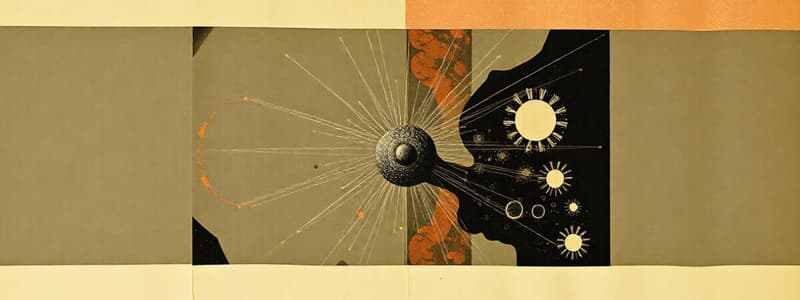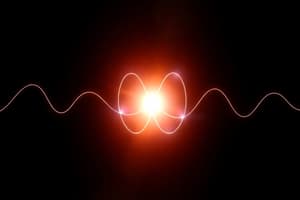Podcast
Questions and Answers
An orbital can be occupied by more than two ______.
An orbital can be occupied by more than two ______.
electrons
The statement that an orbital can be unoccupied is ______.
The statement that an orbital can be unoccupied is ______.
true
According to the options, the incorrect statement about orbitals is that they can be occupied by ______ electrons.
According to the options, the incorrect statement about orbitals is that they can be occupied by ______ electrons.
more than two
Electrons can occupy an orbital in pairs, with a maximal of ______ electrons per orbital.
Electrons can occupy an orbital in pairs, with a maximal of ______ electrons per orbital.
The options provided relate to the characteristics of ______.
The options provided relate to the characteristics of ______.
The ______ principle states that the location of a very small particle like the electron cannot be exactly known.
The ______ principle states that the location of a very small particle like the electron cannot be exactly known.
The region of space around the nucleus where the electron is most likely to be found is called an ______.
The region of space around the nucleus where the electron is most likely to be found is called an ______.
The quantum mechanical model of the atom comes from the mathematical solution to the ______ equation.
The quantum mechanical model of the atom comes from the mathematical solution to the ______ equation.
The shells surrounding the nucleus are also called ______ energy levels.
The shells surrounding the nucleus are also called ______ energy levels.
Electrons exist in sublevels assigned with letters such as s, p, d, f, and ______.
Electrons exist in sublevels assigned with letters such as s, p, d, f, and ______.
As the distance of the dots goes farther away from the center, the number of dots per unit ______ decreases.
As the distance of the dots goes farther away from the center, the number of dots per unit ______ decreases.
To determine the percent probability of finding a dot, you multiply the number of dots/______ by the total number of dots.
To determine the percent probability of finding a dot, you multiply the number of dots/______ by the total number of dots.
The percent probability of finding a dot in circle 1 is calculated using the formula: percent probability = no. of dots/______ × 100.
The percent probability of finding a dot in circle 1 is calculated using the formula: percent probability = no. of dots/______ × 100.
In circle 1, the percent probability of finding a dot is 19.20% when the number of dots/______ is 0.1920.
In circle 1, the percent probability of finding a dot is 19.20% when the number of dots/______ is 0.1920.
The distance with the highest probability of finding a dot can be visualized in the ______.
The distance with the highest probability of finding a dot can be visualized in the ______.
The activity demonstrates that it is not possible to know the exact ______ of the electron.
The activity demonstrates that it is not possible to know the exact ______ of the electron.
Bohr’s idea that electrons are found in ______ orbits around the nucleus was eventually rejected.
Bohr’s idea that electrons are found in ______ orbits around the nucleus was eventually rejected.
Physicist Louie de Broglie proposed that the electron could also be a ______.
Physicist Louie de Broglie proposed that the electron could also be a ______.
The symbol 'n' in the Bohr theory of atomic structure refers to the ______.
The symbol 'n' in the Bohr theory of atomic structure refers to the ______.
Rutherford’s model of the atom concentrated on the nucleus while Bohr’s model focused on the ______.
Rutherford’s model of the atom concentrated on the nucleus while Bohr’s model focused on the ______.
Which configuration is possible in an excited state of an electron? A. 1H : 1d1, B. 2He : 1s2, C. 11Na : 1s2 2s2 2p6 3d1, D. 10Ne : 1s2 2s2 2p5 3s1 - The answer is _____
Which configuration is possible in an excited state of an electron? A. 1H : 1d1, B. 2He : 1s2, C. 11Na : 1s2 2s2 2p6 3d1, D. 10Ne : 1s2 2s2 2p5 3s1 - The answer is _____
The following are rules/principles used in arranging the electrons around the nucleus of an atom EXCEPT: A. Hund’s Rule, B. Aufbau Principle, C. Pauli Exclusion Principle, D. Heisenberg’s ______ Principle.
The following are rules/principles used in arranging the electrons around the nucleus of an atom EXCEPT: A. Hund’s Rule, B. Aufbau Principle, C. Pauli Exclusion Principle, D. Heisenberg’s ______ Principle.
For a neutral atom with the electron configuration of 1s2 2s2 2p5 3s1, which statement is FALSE? A. The atomic number is ten, B. The atom is in ground state, C. The atom is in an excited state, D. The ______ and 2s orbitals are filled.
For a neutral atom with the electron configuration of 1s2 2s2 2p5 3s1, which statement is FALSE? A. The atomic number is ten, B. The atom is in ground state, C. The atom is in an excited state, D. The ______ and 2s orbitals are filled.
Which of the following sublevels is correctly designated? A. 1p5, B. 2p6, C. 3f9, D. 3d11 - The answer is _____
Which of the following sublevels is correctly designated? A. 1p5, B. 2p6, C. 3f9, D. 3d11 - The answer is _____
Which electron transition results in the emission of energy? A. 1s to 2s, B. 2s to 2p, C. 3p to 3s, D. 3p to 4p - The answer is _____
Which electron transition results in the emission of energy? A. 1s to 2s, B. 2s to 2p, C. 3p to 3s, D. 3p to 4p - The answer is _____
How many orbitals are in the third principal energy level? A. 3, B. 6, C. 9, D. 12 - The answer is _____
How many orbitals are in the third principal energy level? A. 3, B. 6, C. 9, D. 12 - The answer is _____
The arrangement of electrons in atoms is described in terms of the probability of finding an electron in certain ______.
The arrangement of electrons in atoms is described in terms of the probability of finding an electron in certain ______.
In Activity 2, a dot is drawn at the center of the sheet of paper to represent the ______ of an atom.
In Activity 2, a dot is drawn at the center of the sheet of paper to represent the ______ of an atom.
To conduct the experiment, one must drop a pencil or marker to leave 100 ______ on the circles drawn on paper.
To conduct the experiment, one must drop a pencil or marker to leave 100 ______ on the circles drawn on paper.
The radius of each concentric circle drawn around the dot is measured in ______.
The radius of each concentric circle drawn around the dot is measured in ______.
After counting the number of dots in each circle, the next step is to calculate the number of dots per square ______.
After counting the number of dots in each circle, the next step is to calculate the number of dots per square ______.
Flashcards are hidden until you start studying
Study Notes
Atomic Models
- Rutherford's model of the atom focused on the nucleus.
- Bohr's model focused on electrons.
- Bohr's model describes electrons existing at different energy levels in orbits around the nucleus.
Electron Transitions
- Electron transitions can result in the emission or absorption of energy.
- An electron transition from a higher energy level to a lower energy level results in the emission of energy.
- An electron transition from a lower energy level to a higher energy level requires the absorption of energy.
Electron Configuration
- The symbol "n" in the Bohr theory of atomic structure refers to the orbit in which an electron is found.
- The sublevels within an energy level are assigned with letters: s, p, d, f, and g.
- The number of orbitals in a given principal energy level is determined by the equation n^2, where n is the principal energy level.
- An excited state is when an electron occupies a higher energy level than its ground state.
- The fifth principal energy level contains s, p, d, f, and g orbitals.
- The quantum mechanical model views an electron as a cloud of negative charge having a certain geometrical shape.
- This model shows how likely an electron could be found in various locations around the nucleus.
Rules and Principles
- Hund's Rule states that electrons will individually occupy each orbital within a subshell before doubling up in any one orbital.
- The Aufbau Principle states that electrons fill orbitals in order of increasing energy.
- The Pauli Exclusion Principle states that no two electrons in an atom can have the same set of four quantum numbers.
- Heisenberg's Uncertainty Principle states that it is impossible to know both the position and momentum of an electron simultaneously.
Atomic Orbitals
- An atomic orbital is a region of space around the nucleus where an electron is most likely to be found.
- An orbital can be unoccupied, occupied by one electron, or occupied by two electrons.
- An orbital cannot be occupied by more than two electrons.
Studying That Suits You
Use AI to generate personalized quizzes and flashcards to suit your learning preferences.




